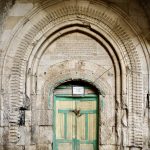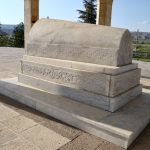Birthplace of Nasrettin Hoca Population: 400
Old name: Hortu
 Driving from İstanbul to Ankara with time on your hands you could divert south through Eskişehir and then head east through lovely old Sivrihisar. For those with children this a particularly good idea since the road then continues east and skirts a village with the tell-tale name of Nasrettin Hoca.
Driving from İstanbul to Ankara with time on your hands you could divert south through Eskişehir and then head east through lovely old Sivrihisar. For those with children this a particularly good idea since the road then continues east and skirts a village with the tell-tale name of Nasrettin Hoca.
Nasrettin Hoca was a medieval comedian-cross-philosopher, a kind of Central Asian take on Aesop usually depicted as a bearded middle-aged man of jovial demeanour wearing an outsize turban and sitting back to front on his donkey.
The story has it that Nasrettin Hoca was born in Hortu some time around 1208, a fact that the locals have no intention of letting you forget. As you near the village you will spot a giant statue of the hoca in the forecourt of the nearest petrol station. Another stands sentinel at the junction with the road to the village.
Turning off the highway you’ll find yourself in a very pretty piece of rural Turkey where poplars and willows hedge the fields and the rest of the world suddenly seems to drop away. Then you turn a corner and land in a sort of Never Never Land where Peter Pan has given way to the hoca. Every wall, every street corner, every house is festooned with titbits of Nasrettin Hoca wisdom, interspersed here and there with snatches of poetry from Yunus Emre and pithy sayings of Atatürk.
They are not the only peculiarity of this particular village for all the houses have been painted with thick bands of contrasting colour so that for one wild moment you think you’ve fetched up in a place where all the inhabitants are ardent fans of obscure football teams. It sounds outlandish but actually works rather well, giving the village a quirky, colourful originality.
Nasrettin Hoca is too small to boast many specific sites. There’s a large main square whose centrepiece is the predictable tea-house where elderly men idle the day away. Inevitably there’s a third statue of the hoca and his donkey there too.
Then the narrow streets wind downhill towards what advertises itself as his birthplace but is in fact a faux-Ottoman house-museum.
 There’s not much to do in Nasrettin Hoca apart from admire the assorted images of its famous son and ponder what his witty stories tell us not just about life in medieval Anatolia but also about human nature (for more examples go to www.readliterature.com/Hocastories.htm).
There’s not much to do in Nasrettin Hoca apart from admire the assorted images of its famous son and ponder what his witty stories tell us not just about life in medieval Anatolia but also about human nature (for more examples go to www.readliterature.com/Hocastories.htm).
You may wonder why the Hocaisms are interspersed with lines from Yunus Emre, the great mystical poet and a near contemporary of his who is believed to have lived from around 1240 to around 1321. Rarely can two men have appeared to have less in common than these two but in fact Emre’s poems are also well known for the way in which they can be read on several different levels. Perhaps more importantly for the passing traveller the village of Yunus Emre lies not far away from Nasrettin Hoca and is one of seven different places competing for the accolade of hosting his last resting place.
Transport info
Buses from Eskişehir to Ankara pass the junctions for Nasrettin Hoca and Yunus Emre. Without your own transport you should get out at the petrol station marked by the statue of the hoca and ask someone to call a taxi for you.
Alternatively, hire a taxi from Sivrihisar to take you to both Nasrettin Hoca and Yunus Emre. Agree a return fare including waiting time before setting out.



